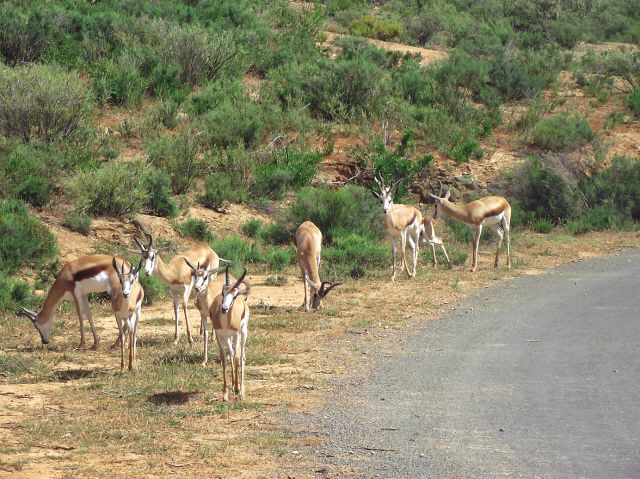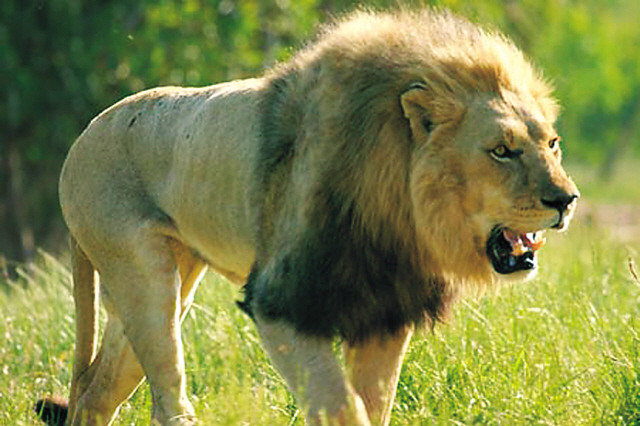
CAPETOWN, South Africa ― “What will you do?” our mustachioed safari guide Deon Gericke asked. Each of us in turn gave our guesses on how to best to survive an impromptu encounter with a lion in the wild.
“Firstly, take your glasses off and make eye contact because eyes on the front is a meat eater. Eyes over here is an herbivore,” he continued, pointing to the side of his head. “The lions know that, so hopefully they are going to be backing off and look at me and see that I am meat eater.”
Some 3 meters from our vehicle, a docile-looking male lion sat basking in the low morning sun. Nearby a female skulked among the bushes. Another girl lay sprawled a few meters away. So silent and graceful were their movements, it was almost possible to forget that these were natural killing machines.
“Firstly, take your glasses off and make eye contact because eyes on the front is a meat eater. Eyes over here is an herbivore,” he continued, pointing to the side of his head. “The lions know that, so hopefully they are going to be backing off and look at me and see that I am meat eater.”
Some 3 meters from our vehicle, a docile-looking male lion sat basking in the low morning sun. Nearby a female skulked among the bushes. Another girl lay sprawled a few meters away. So silent and graceful were their movements, it was almost possible to forget that these were natural killing machines.

These lions were primarily fed chicken, we were told, as white meat is thought to suppress their killing instinct. But even with the assurance that lions were not among the five animals to instinctively attack humans (the polar bear, leopard seal, Komodo dragon, wolf and African dog), it was still hard to imagine ever following our guide’s second piece of advice on avoiding an attack.
“Secondly, make yourself as big as you can … then you scream as loud as you can ― that is not difficult, ask me, it is very easy, it is natural ― then you run as fast as you can. But (if) you run away it is suicide ― you charge the lion. They say you have an 85 percent chance of surviving.”
We were regaled with numerous other such facts, figures and tales throughout our morning safari at Fairy Glen Private Game Reserve, about an hour’s drive from Cape Town. We also learned about one, albeit disputed, theory for how the white rhino got its name: The Dutch word “wijd” (meaning wide) was mistranslated as “white” by the English.
No amount of information could compare, however, with seeing some of nature’s most impressive creatures in the flesh. At some 20,000 hectares, Glenn Fairy is relatively compact compared to other reserves, but its biggest draw is how close visitors can expect to get to at least four of Africa’s “Big 5”: the lion, rhino, buffalo, elephant and, mostly nocturnal, leopard.
Apart from the elusive latter animal, we managed to get almost within touching distance of every one, as well as the supremely graceful zebra, springbok and eland, a type of antelope spiritually revered by the Bushman because the sound it makes as it walks resembles their clicking language. Our guide, however, had no such kind words to describe the unfortunate wildebeest.
“The wildebeest here, a lot of people get confused, they call them buffalo,” said Gericke. “You would be surprised how many people go, oh, look, buffalo.’ That is not even related to buffalo, that is an antelope. It is the ugliest antelope that was ever created.”
Visitors to Fairy Glen can make an extended stay out of their trip, sleeping in one of a number of cozy chalets on the grounds, with meals included. Each chalet comes with a gaping fireplace and decanter of port to keep the chilly South African night at bay. For visitors from Korea, there will be at least one good reason to venture out after dark ― the night sky’s tapestry of vividly glistening stars. During the day, the surrounding landscape, dominated by the imposing, jagged Brandwacht Mountains, is an equally impressive spectacle.
The only letdown of our stay was the unfortunate discovery of a dead cockroach in the coffee at breakfast, for which the staff was apologetic and seemed genuinely embarrassed. Other than that, the dinner buffet was varied and of good quality, providing local tastes in lamb, pap ― a staple of ground maize ― and malva pudding, a dessert reminiscent of sticky toffee pudding.
The most memorable moment of our stay, and also the most poignant, predictably involved the animals. The park’s two rhinos had had their horns brutally removed by poachers at the end of 2011. More than a year later, one still bore a deep, red wound where its horn had literally been hacked from its head.
“It is a miracle that the two survived,” said Gericke, with a note of sadness in his voice. “They are doing very well without the horns. That’s why the buffalo and elephant are separate (from them).”
Despite the animals’ ordeal there was cause for hope in the form of new life. One of the rhinos, we were told, was possibly pregnant.
“If she’s pregnant, it’s about 18 months to wait. So I don’t know why women complain about nine months ― you could have been a rhino, or elephant (pregnant) for two years,” Gericke joked.
For bookings and more information, visit www.fairyglen.co.za.
By John Power (john.power@heraldcorp.com )
-
Articles by Korea Herald








![[KH Explains] Hyundai-backed Motional’s struggles deepen as Tesla eyes August robotaxi debut](http://res.heraldm.com/phpwas/restmb_idxmake.php?idx=644&simg=/content/image/2024/05/16/20240516050605_0.jpg&u=20240516155018)










![[Today’s K-pop] NewJeans hits 600m Spotify streams with ‘Ditto’](http://res.heraldm.com/phpwas/restmb_idxmake.php?idx=642&simg=/content/image/2024/05/17/20240517050510_0.jpg&u=)